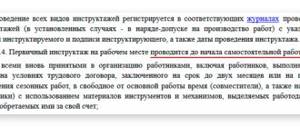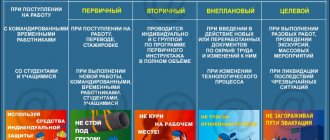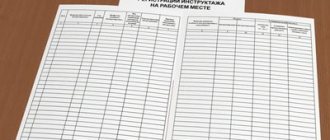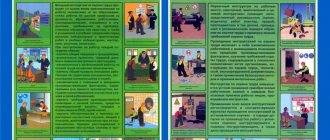What documents regulate workplace training?
Today in the Russian Federation there are three main documents at the federal level regulating the issues of conducting labor safety briefings:
- Labor Code;
- The procedure for training in labor protection and testing knowledge of labor protection requirements for employees of organizations, approved by Resolution of the Ministry of Labor of Russia and the Ministry of Education of Russia dated January 13, 2003 No. 1/29 (hereinafter referred to as the Procedure for training in labor protection);
- GOST 12.0.004-90 SSBT “Organization of occupational safety training. General provisions" (hereinafter referred to as GOST 12.0.004-90 SSBT).
The procedure for training in labor protection and GOST 12.0.004-90 SSBT, in fact, are complementary analogues of each other, having the same legal force. They specify the procedure for conducting briefings and the specifics of recording their results.
There are also special industry and inter-industry documents on labor protection (for example, rules, standard instructions, etc.) that establish certain requirements for employees to undergo training. Of these documents, the most relevant for office workers are the Standard Instructions on Labor Safety when working on a personal computer (TOI R-45-084-01) and the Standard Instructions on Labor Safety when working on copying equipment (such as “Canon”, “ Xerox, etc.) (TI RO 29-001-009-02).
Safety training, necessary documents
Temperature in the office according to sanitary standards
The person responsible for conducting the training is a labor protection specialist.
On a note. If the number of the company is no more than 50 workers, then the instruction is carried out either by the head of the company or a hired specialist with the appropriate education.
Step-by-step algorithm on how to start instruction:
- The responsible person conducts a conversation with the employee.
- The documents necessary for the briefing are prepared.
- The occupational safety specialist talks about the rules of conduct, safety principles and all other necessary information to ensure safe work activities.
- An oral survey is conducted about the information provided.
- The result of the briefing is recorded in a journal.
OT training
The employer is required to keep training logs. Such magazines include:
- induction magazine, which contains information about new employees;
- journals of primary, repeated, etc. briefings containing information about all employees who have undergone the briefing;
- fire safety briefing log - information about fire safety training is entered.
If there are employees working in the office who are not involved in the operation, repair, testing of equipment, or who do not use electrified tools, then the employer has the right to exempt them from initial training.
What sections does a workplace training program consist of?
No regulatory act regulates the structure of occupational safety training programs in the workplace. Only GOST 12.0.004-90 SSBT contains in Appendix 5 an approximate list of the main questions of the initial briefing, consisting of 10 points.
Guided by the generally accepted structure of labor protection instructions (including standard ones), as well as the requirements of the Labor Safety Training Procedure and GOST 12.0.004-90 SSBT, the workplace safety requirements must be included in the workplace training program:
- are common;
- before starting work;
- during work;
- in emergency situations;
- upon completion of work.
At the end of the program, it is recommended to provide a list of literature, regulatory, reference and methodological documents and materials regulating labor protection requirements for office workers. For example:
- Labor Code.
- The procedure for training in labor protection and testing knowledge of labor protection requirements for employees of organizations, approved by Resolution of the Ministry of Labor of Russia and the Ministry of Education of Russia dated January 13, 2003 No. 1/29.
- GOST 12.0.004-90 SSBT “Organization of occupational safety training. General provisions."
- GOST 12.2.032-78 SSBT “Workplace when performing work while sitting. General ergonomic requirements."
- GOST 12.2.003-91 SSBT “Production equipment. General safety requirements."
- SanPiN 2.2.2/2.4.1340-03 “Hygienic requirements for personal electronic computers and work organization and others.”
This will help the manager conducting the program briefing to refresh his memory of the necessary knowledge and provide the office worker with information about the occupational safety and health documents recommended for review.
General labor protection requirements
1.1. Work in the office using personal computers, copying equipment, fax machines and other office equipment is allowed to employees who have the appropriate qualifications for the work performed, who have undergone introductory and initial workplace safety briefings, and who have been trained in labor safety when working with office equipment.
1.2. From the time pregnancy is established, women should be transferred to jobs that do not involve the use of personal computers, or their time working with a personal computer should be limited (no more than 3 hours per work shift).
1.3. To perform work with office electrical equipment, you should study the instructions for its operation, undergo training and obtain Group I in electrical safety.
1.4. Office workers who perform work using personal computers, copying equipment, fax machines and other office equipment, regardless of qualifications and work experience, must undergo repeated training on labor protection at least once every six months.
1.5. In case of violation of labor safety requirements, during a break in work for more than 60 calendar days, employees must undergo unscheduled training.
1.6. Office workers who have not received timely instructions on labor protection and do not have Group I in electrical safety are not allowed to work independently.
1.7. Office workers who have demonstrated unsatisfactory skills and knowledge of safety requirements when working with office equipment are not allowed to work independently.
1.8. Office workers allowed to work permanently on a personal computer (more than 50% of the working time) must undergo medical examinations before entering work and periodically thereafter (at least once a year).
1.9. Office workers allowed to work independently must know: technical operating rules and safety requirements when working with office equipment, methods of rational organization of the workplace, sanitary and hygienic requirements for working conditions, dangerous and harmful production factors that can have an adverse effect on humans .
1.10. An office worker sent to participate in work unusual for his position must undergo targeted training on the safe performance of the upcoming work.
1.11. Office workers are prohibited from using tools, devices and equipment that they have not been trained to use safely.
1.12. While working, an office employee may be exposed mainly to the following dangerous and harmful production factors:
- overstrain of the visual analyzer during prolonged work at the monitor screen;
- prolonged static tension in the muscles of the back, neck, arms and legs, which can lead to static overloads;
- ionizing and non-ionizing radiation, the sources of which are personal computer monitors;
- static electricity;
- moving parts of copying and duplicating equipment;
- contamination of hands with chemicals contained in paints and powders of copying equipment;
- insufficient illumination of the workplace;
- electric current, the path of which, in the event of a short circuit to the housing, can pass through the human body.
1.13. Office workers, especially those working on personal computers, must comply with the work and rest schedules established for them.
1.14. To prevent the possibility of a fire, office workers must comply with fire safety requirements themselves and prevent violations by other workers and visitors.
1.15. To prevent diseases, you should know and follow the rules of personal hygiene.
1.16. If you become ill or feel unwell, you should report your condition to your immediate supervisor and seek medical help.
1.17. If an employee witnesses an accident, he must provide first aid to the victim and report the incident to the manager.
1.18. Office workers must be able to provide first aid, including in case of electric shock, and use a first aid kit.
1.19. An office worker who violates or fails to comply with labor safety instructions is considered a violator of production discipline and may be subject to disciplinary action, and, depending on the consequences, even criminal liability.
1.20. If the violation involves causing material damage, the perpetrator may be held financially liable in the prescribed manner.
How to apply modern methods to instruct office workers?
The traditional approach to instructing office workers is a rather boring exercise. Moreover, in some cases it is difficult to carry out. In particular, this applies to companies that have a wide network of branches and representative offices throughout the country, as well as abroad. The situation is aggravated by the fact that there is usually only one occupational safety specialist. Therefore, it is problematic for him to provide instructions to each new employee. The occupational safety specialist is forced to travel on a schedule to the regions where there are representative offices and branches. This entails large travel expenses, not counting the time costs.
As for workplace instruction, it, as a rule, is also not original. Therefore, some organizations began to use an electronic briefing system.
Unlike traditional instruction, when the instructor speaks in front of an audience, in the electronic version of the course, each student goes through the necessary material himself, completing tasks to confirm that he has mastered the theory. The latter allows you to avoid a formal approach in which employees would simply sign in the column “I have read the material,” treating the information as a bureaucratic routine.
The same goal is pursued by the electronic course, which consists of a set of situations simulating various incidents that can happen to employees in different parts of the office: in the kitchen, near the elevator, in the corridors or directly at the workplace. Workers are encouraged to independently find the correct way out of the situation, as well as means to prevent danger. For example, one of the sections plays out a short scene with an employee finishing work. After the introductory part, the student is asked to indicate what actions need to be taken before leaving the workplace. If, for example, he does not turn off electrical appliances, the program demonstrates that a fire may start.
As practice has shown, when a person feels himself in the center of events, he absorbs information with more enthusiasm than when he simply hears a list of precautions.
At the same time, despite the game component, the electronic course cannot be “lost” - anyone who starts it is guaranteed to receive and assimilate all the necessary information upon completion. That is, if a student does not notice any harmful factors, the program will prompt him to look more carefully.
The e-course may cover the following topics:
- working hours and the need for periodic breaks;
- straight posture when working at the computer;
- correct distance between the monitor and the eyes;
- maintaining order and silence;
- the danger of prolonged operation under direct air flow from the air conditioner;
- the need to avoid direct rays of light falling on the monitor or into the eyes, as well as the dangers of working in the dark;
- harm from trying to eat in the workplace;
and etc.
Each topic is separated by an illustrated title, immersing the student in the subject of the next situation.
An approximate list of the main questions of initial briefing (according to GOST 12.0.004-90):
- General information about the technological process and equipment at a given workplace, production site, or workshop. The main dangerous and harmful production factors arising during this technological process.
- Safe organization and maintenance of the workplace.
- Dangerous areas of a machine, mechanism, device. Equipment safety equipment (safety, braking devices and guards, locking and alarm systems, safety signs). Requirements for the prevention of electrical injuries.
- The procedure for preparing for work (checking the serviceability of equipment, starting devices, tools and devices, interlocks, grounding and other protective equipment).
- Safe working practices and methods; actions in the event of a dangerous situation.
- Personal protective equipment at this workplace and rules for their use.
- Scheme of safe movement of workers on the territory of a workshop or site.
- Intrashop transport and lifting equipment and mechanisms. Safety requirements for loading and unloading operations and transportation of goods.
- Typical causes of accidents, explosions, fires, cases of industrial injuries.
- Measures to prevent accidents, explosions, fires. Responsibilities and actions in case of an accident, explosion, fire. Methods of using fire extinguishing means, emergency protection and alarm systems available on the site, and their locations.
You see, nothing superfluous! Just what the worker needs to know. Well, this is of course just an approximate list. I would add more methods of first aid here, combine paragraphs 9 and 10 into one, combine paragraphs 1-4 into one, remove “actions in the event of a dangerous situation” from paragraph 5, since this duplicates paragraph 10. Well, this so, little by little.
The purpose of the program, in essence, is to prevent the person conducting the training from forgetting what instructions the employee should read.
There are no more requirements for writing a labor safety briefing program other than those that I have listed. This means that the program can be presented in any form.
I would like to show a version of the initial training program at the workplace, using the example of an operator producing basalt-plastic reinforcement.
Which office employees may not undergo training?
Employees who are not involved in:
- with operation, maintenance, testing, adjustment and repair of equipment;
- using an electrified or other tool;
- storage and use of raw materials and materials (clause 2.1.4 of the Labor Safety Training Procedure).
The list of positions and professions exempt from initial on-the-job training is approved by the employer. It should be noted that such a contingent of workers is also exempt from undergoing repeated instructions on labor protection in the workplace (clause 2.1.5 of the Labor Safety Training Procedure).
In practice, none of the office workers are included in this list. After all, in fact, every office employee is in one way or another connected with the operation of any office equipment, office equipment or equipment (for example, a personal computer, printer, scanner, copying equipment, telephone, fax, etc.). Formally, even the head of each organization in whose workplace a personal computer is installed must undergo initial and repeated briefings on labor protection.
In their desire to minimize the hassle and paperwork involved in documenting the results of occupational safety and health training, employers often try to free as many office employees as possible from undergoing on-the-job training. In this case, the main danger for the head of the organization is that in the event of an accident or occupational illness with such an employee, serious claims may arise against him from the state labor inspectorate and other inspection organizations. If it turns out that the employee was exempted from instruction without reason, the employer’s guilt will be obvious.
Rules for occupational safety and health of office workers
Occupational safety and health at the enterprise: where to start, step-by-step instructions
Safety instructions for office workers include:
- General labor safety standards - contain requirements for independent work, what responsibilities are assigned and what responsibility is provided for violating labor safety standards.
- Safety requirements before starting work. Contains an algorithm of actions for preparing the workplace. Employee behavior in emergency situations.
- Safety requirements during operation. Employee responsibilities, precautions, compliance with work process rules.
- Labor safety requirements in case of emergency situations. Recommendations for action in case of emergency situations, fire, injury.
- Safety requirements after completion of work.
Remember the main thing
- Be sure to include in your training program labor safety requirements for the operation of all types of equipment, office equipment and equipment installed in the office.
- High-quality and meaningful instructions on labor protection and a training program in the workplace are the key to successfully completed training and, as a result, the absence of complaints about this issue from the inspection authorities.
- Develop and approve a list of professions and positions of employees exempt from undergoing initial training at the workplace.
- Resist the temptation to exempt as many office employees as possible from undergoing workplace safety training. This can be costly for the employer.
Source: Occupational safety: simple and clear
Specific activities of office workers
Although office employees do not face greater health risks than production workers, their work can be unsafe and, in some cases, dangerous if basic workplace safety standards are not ensured.
Employees in the office
The employer is obliged to eliminate traumatic incidents and provide comfortable conditions for employees.
Basic sanitary norms and rules:
- Room temperature. The optimal room temperature is 22-24 degrees. The upper limit in summer is 28 degrees, the lower limit in winter is 22 degrees with an 8-hour working day. If the air temperature in the room exceeds or, conversely, falls below the established norm, then the employer is obliged to reduce the working day in accordance with SanPiN 2.2.4.3359-16.
- Indoor lighting. According to GOST R 55710-2013, the office lighting standard is considered to be from 300 to 500 lux.
- Humidity level. Comfortable humidity in office premises is considered to be between 40-60%.
- Noise level. The standard sound level in the workplace is 80 dBA.
The illustration shows the basic requirements:
Memo on SanPiN







